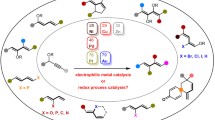Conclusions
-
1.
In the presence of catalysts of basic character, 3,4-epoxyphospholanes are isomerized to 2-phospholen-4-ols.
-
2.
Unsymmetrical 3,4-epoxyphospholanes form a mixture of isomers, with a substantial predominance of the isomer containing a tertiary hydroxyl group.
Similar content being viewed by others
Literature cited
B. A. Arbuzov, L. A. Shapshinskaya, A. P. Rakov, A. O. Vizel', and N. P. Kulikova, USSR Patent No. 212258 (December 19, 1966); Byull. Izobr. No. 9 (1968); B. A. Arbuzov, L. A. Shapshinskaya, A. P. Rakov, A. O. Vizel, and N. P. Kulikova, Izv. Akad. Nauk SSSR, Ser. Khim., 1313 (1968).
B. A. Arbuzov, L. A. Shapshinskaya, A. P. Rakov, A. O. Vizel', and N. P. Kulikova, USSR Patent No. 225187 (June 12, 1967); Byull. Izobr., No. 27 (1968).
A. Weissburger (editor), Heterocyclic Compounds with Three- and Four-Membered Rings, Part I, New York-London-Sydney (1964), p. 1.
M. S. Malinovskii, Olefin Oxides and Their Derivatives [in Russian], Goskhimizdat (1961), p. 30.
Z. G. Isaeva and B. A. Arbuzov, Synthetic Products from Rosin and Turpentine [in Russian], Nauka i Tekhnika, Minsk (1964), p. 203.
J. K. Crandall and Luan-Ho Chang, J. Org. Chem.,32, 435 (1967).
Some Problems in Organic Chemistry [in Russian], Izd. Kazansk. Gos. Univ. (1964), 161.
A. E. Arbuzov and A. I. Ruzumov, Zh. Russ. Fiz.-Khim. Obshchvesta,61, 623 (1929); Selected Works [in Russian], Izd. AN SSSR (1952), 312.
A. E. Arbuzov, Selected Works [in Rssian], Izd, AN SSSR (1952), p. 19; A. L. Troitskaya, Tr. Kazansk. Khim.-Tekhnol. Inst.,83, 228 (1957).
A. N. Pudovik and N. M. Lebedeva, Dokl. Akad. Nauk SSSR,90, 799 (1953); M. I. Kabachnik, T. Ya. Medved, and E. I. Magrosov, Dokl. Akad. Nauk SSSR,162, 339 (1965).
A. N. Pudovik, Usp. Khim.,23, 547 (1954).
N. Kreutzkamp, Ber.,88, 195 (1955); Angew. Chem.,69, 393 (1957).
L. Horner, H. Hoffmann, and H. G. Wippel, Ber.,91, 61 (1958).
L. Horner, H. Hoffmann, H. G. Wippel, and G. Klahre, Ber.,92, 2499 (1959).
F. F. Blicke and S. Raines, J. Org. Chem.,29, 2036 (1964).
A. V. Dombrovskii and G. V. Grinev, Ukr. Khim. Zh.,34, 171 (1968).
L. J. Bellamy, Infrared Spectra of Complex Molecules [Russian translation], IL (1963), p. 54.
H. Weitkamp and F. Körte, Z. Anah Chem.,204, 245 (1964).
U. Hasserodt, K. Hunger, and F. Korte, Tetrahedron,19, 1563 (1963).
Author information
Authors and Affiliations
Additional information
Translated from Izvestiya Akademii Nauk SSSR, Seriya Khimicheskaya, No. 1, pp. 85–90, January, 1970.
In conclusion the authors sincerely express their gratitude to Z. G. Isaeva for a number of valuable suggestions, made during the course of the work and in interpreting the results.
Rights and permissions
About this article
Cite this article
Arbuzov, B.A., Rakov, A.P. & Vizel', A.O. Isomerization of 3,4-epoxyphospholanes. Russ Chem Bull 19, 78–82 (1970). https://doi.org/10.1007/BF00913928
Received:
Issue Date:
DOI: https://doi.org/10.1007/BF00913928




